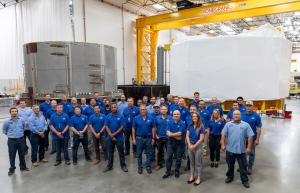US ITER ready to deliver first central solenoid module
This week the "beating heart" of ITER—the central solenoid, the largest of ITER's magnets—will take the first step in the final lap of a decade-long journey. Over the next few days, it will be loaded onto a special heavy transport vehicle at General Atomics near San Diego, California, bound for the port of Houston, where it will be re-loaded onto a ship bound for Marseille. By early September, it will reach its final destination, the ITER worksite, where it will meet the rest of the superconducting "ITER magnet family" and take its place in the machine.
Creating the magnetic cage that will shape and control the ITER fusion plasma calls for three primary magnet arrays: the D-shaped vertical array of "toroidal field coils," the horizontal layer of ring-shaped "poloidal field coils," and the central solenoid positioned in the central axis.
The unique role of the central solenoid is to direct a pulse of current in the plasma that circulates around the torus—hence the "beating heart" moniker. But this is no normal heartbeat. The size and strength of ITER's central solenoid—a stack of six modules, plus support structures, that together boast a height of 18 metres, a weight of more than a thousand tonnes, and a magnetic field strength of 13 Tesla at its core—will enable a current of 15 million amperes in 400-second pulses, more powerful and more sustained than any previous tokamak.
To manufacture this behemoth, General Atomics created the Magnet Technologies Center as a fit-for-purpose facility. After a four-year collaboration with US ITER on the design and tooling, fabrication of the first module started in 2015.
Each module required more than two years of precision fabrication, carefully winding more than 5 kilometres of steel-jacketed niobium-tin superconducting cable into precise flat discs, then splicing together enough discs to create the full module. Five weeks of heat treatment followed: baking the module evenly in a giant convection-style furnace. Delicately stretching the module coils—much like a giant Slinky toy—allowed the individual turns to be wrapped in fiberglass-Kapton insulation to avoid electrical shorting across the windings. And finally, with the module inserted into a special mould, 3,800 litres of epoxy resin were injected under vacuum, saturating the insulation material, eliminating bubbles, and fusing the module into a structural whole.
In February, the first module passed a demanding series of tests; but it waited on standby as the second module was run through a similar series, as an extra precaution to allow any lessons learned to be applied.
And now, freshly wrapped for travel over land and sea, Module 1 is heading off to take its place as the first of its kind at ITER. Six more modules (one as a spare) will follow in a series, all of them to be installed in 2023-2024. And not so long after that, ITER's scientists will stand by anxiously as their colossal newborn generates its first heartbeat.
To view the making of the central solenoid, see this video from General Atomics.
Read more about the fabrication process in this booklet.


